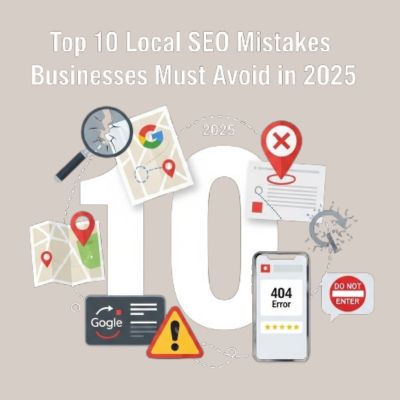Top 10 Local SEO Mistakes Businesses Must Avoid in 2025

In today’s competitive digital landscape, having a strong local SEO strategy is crucial for small and medium businesses. Local search optimization ensures your business appears in front of nearby customers when they search for products or services you offer. However, many businesses unknowingly make local SEO mistakes that hurt their rankings, reduce visibility on Google Maps, and lead to lost sales. Studies show that over 46% of all Google searches are local, yet many businesses fail to capitalize on this traffic.
Not Optimizing Google Business Profile Properly
Your Google Business Profile (GBP) is often the first interaction a potential customer has with your business online. Unfortunately, many businesses either neglect it or optimize it incorrectly.
Common mistakes include:
- Incomplete business information
- Wrong business categories
- Outdated photos and business hours
- Inconsistent NAP (Name, Address, Phone)
Why it matters: A fully optimized Google My Business listing can boost your rankings in local search results and Google Maps visibility. Businesses with complete profiles receive up to 7x more clicks than those without.
Tips for optimization:
- Complete all fields accurately, including business description and services
- Add high-quality images and videos showcasing your products, team, or location
- Update business hours regularly and include holiday hours
- Ensure the correct category and subcategories
Example: A local bakery updated their GBP with accurate hours, high-quality images, and detailed service descriptions. Within three months, their Google Maps visibility increased by 65%, resulting in a significant rise in walk-in customers.
Inconsistent NAP Across Listings
Maintaining consistent Name, Address, and Phone number (NAP) across all online directories is critical.
Mistakes to avoid:
- Using different abbreviations for business name
- Wrong addresses or outdated phone numbers
- Ignoring citation management across online directories
Why it matters: Google cross-checks NAP across directories. Inconsistencies reduce trustworthiness and can harm your local search ranking.
Tips:
- Audit all online listings regularly
- Use tools like Moz Local or Yext to manage citations
- Ensure NAP matches exactly with your Google Business Profile
Example: A plumbing service found 20 online directories with inconsistent addresses. After standardizing all listings, they saw a 40% improvement in local search rankings within two months.
Ignoring Local Keywords
Many businesses focus only on generic keywords and neglect location-based keywords.
Mistakes to avoid:
- Targeting only high-traffic generic terms
- Not including city, neighborhood, or landmark names in content
- Ignoring local search queries in blogs or landing pages
Tips:
- Conduct local keyword research using Google Keyword Planner or Ahrefs
- Include city or neighborhood names in titles, headings, and meta descriptions
- Create location-specific landing pages for each service area
Example: A dental clinic targeting “dentist near me in Mumbai” added city-specific landing pages for each suburb. Their local search traffic increased by 55% in six months.
Not Getting Enough Reviews
Online reviews are a major factor in local search rankings and customer trust.
Mistakes to avoid:
- Ignoring reviews completely
- Posting fake reviews or incentivizing them incorrectly
- Not responding to negative or positive feedback
Why it matters: Google uses reviews as a ranking factor, and positive reviews build credibility. Customers are 68% more likely to choose a business with 5-star reviews.
Tips:
- Encourage genuine reviews via email campaigns or in-store requests
- Respond professionally and promptly to all reviews
- Highlight positive reviews on your website and social media
Example:A local cafe actively requested reviews via email after every visit. Within three months, they received 120 new positive reviews, resulting in a higher Google Maps ranking and more foot traffic.
Poor Mobile Experience
With Google’s mobile-first indexing, having a mobile-friendly website is critical.
Mistakes to avoid:
- Slow page loading speed
- Non-responsive website design
- Broken links or poor navigation
Tips:
- Use responsive design that adapts to all screen sizes
- Compress images and optimize code for faster loading
- Test user experience on multiple mobile devices
Example: A local gym redesigned its website to be mobile-friendly. Mobile visitors increased by 70%, and local SEO rankings improved as a result.
Neglecting Local Content
Creating locally relevant content is essential for engaging the community and improving rankings.
Mistakes to avoid:
- Writing generic, location-agnostic content
- Ignoring local events, news, or community topics
- Missing opportunities for neighborhood SEO
Tips:
- Create blog posts about local events, success stories, or guides
- Add location-specific landing pages for different service areas
- Include local keywords naturally in headings and meta descriptions
Example: A landscaping company wrote blog posts on “Best Gardens in Pune neighborhoods.” Their local organic traffic increased significantly, attracting clients from multiple suburbs.
Not Using Structured Data / Schema
Schema markup for local business helps Google understand your business better and display rich snippets.
Mistakes to avoid:
- Missing structured data for address, hours, or reviews
- Not implementing JSON-LD or microdata
Tips:
- Implement structured data for NAP, services, reviews, and events
- Use Google’s Structured Data Testing Tool to validate
- Update schema whenever business info changes
Example:A pet clinic implemented a schema for services, reviews, and events. Their click-through rate from Google Maps listings improved by 30% in four months.

Ignoring Local Backlinks
Backlinks from local sources signal authority to search engines.
Mistakes to avoid:
- Relying only on directories
- Not collaborating with local publications or partners
Tips:
- Partner with local businesses for guest posts or sponsorships
- Submit listings to reputable local directories
- Earn backlinks from local blogs and news sites
Example: A fitness studio collaborated with a local health blog for a guest post. They gained authoritative local backlinks, improving local search rankings significantly.
Overlooking Social Signals
Active social media accounts improve neighborhood SEO indirectly by increasing engagement and website traffic.
Mistakes to avoid:
- Inactive profiles
- Inconsistent NAP across social platforms
- Ignoring engagement with local followers
Tips:
- Share local news, events, or blogs
- Link social profiles to your Google Business Profile
- Engage actively with followers via comments, polls, and messages
Example: A boutique shop shared local event coverage on Instagram and Facebook. Their engagement led to more Google Maps clicks and in-store visits.
Failing to Monitor Performance
Tracking local SEO ranking factors is essential for adjusting strategy and improving results.
Mistakes to avoid:
- No analytics or tracking
- Ignoring click, call, and website data
Tips:
- Use Google Analytics and Search Console
- Monitor local keyword rankings and Google Maps insights
- Adjust strategies based on data trends
Example: A bakery monitored local keyword rankings and adjusted their content based on monthly reports. Their organic local traffic doubled within six months.
Conclusion
Avoiding these top 10 local SEO mistakes can dramatically improve your Google Maps visibility, attract more organic local traffic, and strengthen your small business online presence. Regular audits, optimized content, structured data, and active engagement ensure your business thrives in local searches in 2025. By following these strategies, businesses can stay ahead of competitors and fully leverage local search optimization.
Frequently Asked Question
Q1. Why is Google Business Profile optimization crucial for local search visibility?
A well-optimized Google Business Profile ensures your business shows up for relevant local searches. Optimized profiles include accurate details, images, regular posts, proper categories, and positive reviews, helping you rank higher and attract more customers.
Q2. How does ignoring local backlinks affect my business’s local search ranking?
Local backlinks from reputable websites signal authority and relevance to search engines. Ignoring this can limit your visibility in local search results. Building quality local backlinks from directories, community sites, and local partnerships is essential.
Q3. How important are local reviews for SEO in 2025?
Reviews are critical. They impact rankings, influence user decisions, and improve trust. Responding to both positive and negative reviews shows engagement and boosts credibility.
Q4. How can I check if my local SEO strategy is effective?
Monitor Google Business Profile insights, local search rankings, website traffic from local searches, customer reviews, and local backlinks. Regular audits help identify areas for improvement.
Q5. What role does mobile optimization play in Local SEO success?
Most local searches now happen on mobile devices. A mobile-friendly website with fast loading speed, responsive design, and easy navigation improves user experience, reduces bounce rates, and increases your chances of ranking higher in local search results.